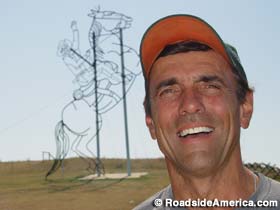Today we visited
the North Dakota Lewis & Clark Interpretive Center
and Fort Mandan.
Paul getting dressed in period clothing!
Fort Mandan was the Corps of Discovery's winter home from 1804-1805. Through the winter, Lewis & Clark interviewed members of the nearby Mandan-Hidatsa villages to plot maps and plan the next phase of their journey to the Pacific Ocean. They also had the good fortune to meet a remarkable young woman named Sacagawea.
Now - Joan means business!
Next we visited
the Missouri River Muzzleloaders
re-enactment group.
This was awesome as they taught us knife throwing as well as hatchet throwing. In addition we fired numerous muzzleloaders. It was a lot of fun. When we finished, they let us try some homemade chicken and biscuits and peach cobbler they had prepared on site for us.
This guy was really good!
Getting ready to throw the hatchet.
While she did great - I'll take my chances
with her hatchet throwing over the big blunder buss any day!!!!
GEE - I actually stuck the hatchet and later the knife the first try!
The kick was not bad!
The food was really really good!
Dave - Posing for the camera!
Day 15 - enroute to Medora we drove through the
"Enchanted Forest"
Enchanted Highway, a 32-mile stretch of paved county highway between Regent and Gladstone, reaching I-94.
Thirty miles south of the nearest major highway, the town of Regent was dying, and Gary Greff decided someone had to do something about it.
A metal sculptor and retired school teacher, Gary started the work in 1990. His master plan was to create ten giant sculptures, one every few miles along Regency-Gladstone Road, paired with picnic areas and playground equipment. All the sculptures face north, toward the oncoming traffic from the interstate. Seven have been completed.
An additional sculpture towers along I-94, essentially an artistic billboard enticing travelers to exit and head south to Regent. Geese in Flight went up in 2001, next to the Gladstone exit -- and it is claimed to be the World's Largest Outdoor Sculpture.
There's a depiction of Teddy Roosevelt riding a bucking horse (3 miles north of Regent) and a Tin Family (1.5 miles north), which includes a propeller-headed boy holding a sucker. A Covey of Pheasants (9 miles north) was completed in fall of 1998. The rooster is 60 feet long, and the hen 50 feet. Three 12-foot high chicks complete the scene. The World's Largest Grasshopper went up in Spring 1999. In September 2002, a giant deer leaping, Deer Crossing, was installed.
In early 2007, Greff completed Fisherman's Dream, his seventh and most complicated sculpture, with metal fish leaping up 70 feet through a metal pond surface.
Gary can't weld during dry months (there was a brush fire at Teddy Roosevelt), but has scheduled his activities (painting, building, etc) out months in advance.
The grand project started years ago with some volunteers. Gary thought local farmers would help, because they knew about metal bending and welding. Some farmers (except one, apparently) did give him good terms on leasing land to show the work, $1 for 20 year lease, with renewal.
Most days it's Gary himself continuing to build the Highway. He does all the maintenance, cuts the grass under the statues, and builds the parking areas and fences. A local boy scout troop and shop class have helped with some of the signs and picnic tables.
Gary is a very cheery greeter, chatting up all of the people who stop while we are at any particular statue with him.
At the end of the Enchanted Highway, in Regent, Gary's excess metal sculpting energies are evident, where trees with metal leaves seemingly bloom. His workshop is in a large metal storage building, and he lives in a trailer.

Gary Greff and Teddy Roosevelt.
Each new construction on the Enchanted Highway is a struggle by the visionary artist, who scrapes together individual donations of money and material.
Gary's bigger dreams are to add a water park, restaurant, and amphitheater. For now, a more modest effort is underway to expand the Enchanted Highway Gift Shop in Regent. But he's achieved enough critical mass that cross-country road trippers should be veering north to I-94 rather than the traditional I-90 crossing through South Dakota. It's worth the detour.
Next Enchanted Highway project: a giant spider web crawling with metal arachnids.
Geese in flight
Deer crossing
Looking back at the Geese in flight from the Deer crossing
World's Largest Grasshopper
Diana and Joan. Diana is truly a "ROSE"
Steve - enjoying the sculptures while taking a break
These are entitled Fisherman's Dream
Not much traffic on the road as we simply stopped to enjoy the sculptures.
Covey of pheasants
Teddy Roosevelt

The Tin Family
The detail is amazing!
This was one of many WOW factors on the trip one MUST see!































































































